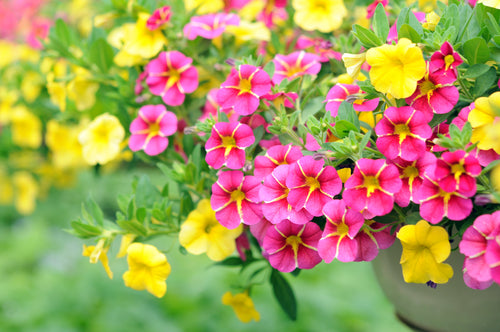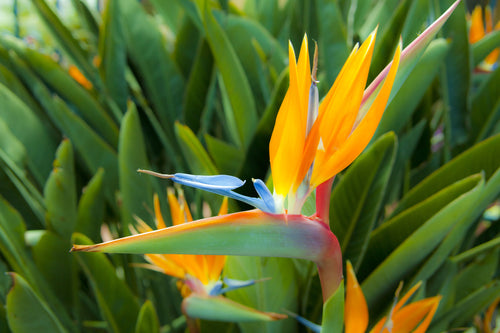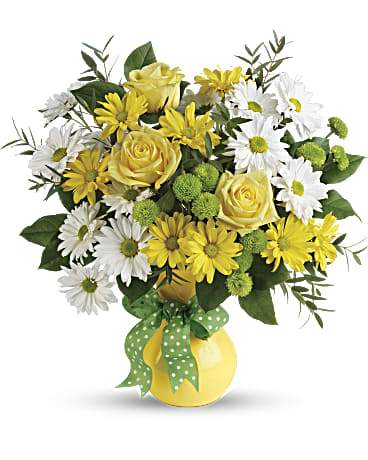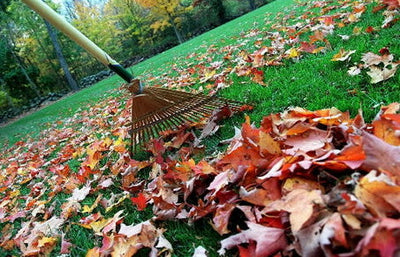HISTORY
Poinsettia, also known as the Christmas plant, remains one of the most popular holiday flowers. With the introduction of long-lasting cultivars, the popularity of the poinsettia has increased significantly. It was introduced to the United States in 1825 by Joel Robert Poinsett, first U. S. ambassador to Mexico who obtained plants from the wilds of southern Mexico.
POINSETTIA CULTIVARS
Pesche’s carries several series of cultivars offering a variety of bract colors:
Peterstar Red – bright red flower bracts
Peterstar Pink – dark pink bracts
Cortez Burgundy – dark red-colored flower bracts
Glitter – bicolored red with pink splotched bracts,
Marble – bicolored pink and creamy white bracts
Pink Peppermint – peppermint colored bracts
Ruby Frost – variegated red and white bract color
Snowcap – creamy white flower bracts,
Turquoise Blue – white bracts customed dyed blue
Purple – white bracts customed dyed purple
SELECTING YOUR POINSETTIA
Select plants with large, brightly colored bracts (red, pink, white or bicolor pink and white) that are not wilted, broken, or damaged, and a full complement of rich, dark green leaves. Healthy leaves should be present even at the base of the plant. The true flowers are the yellowish button-like structures in the center of the bracts. Bracts normally do not last for long periods after the true flowers.
POINSETTIA CARE AND MAINTENANCE
The proper care for your poinsettia begins the moment you walk out of the store. Your poinsettia will be wrapped in a sleeve to protect it from cold and windy weather because exposure to low temperatures even for a few minutes can damage the bracts and leaves. Unwrap your poinsettia as soon as you get home because the petioles (stems of the leaves and bracts) can droop and twist if the plant is left wrapped for too long..
Light
Poinsettias are tropical plants, so when searching for the perfect location, look for warmth and at least six hours of indirect sunlight daily. Do not let any part of the plant touch the cold window since this could injure the plant.
Temperature
Maintain a daytime temperature between 65 and 75 degrees Fahrenheit and nighttime temperature between 60 and 65 degrees Fahrenheit to extend the blooming time. Poinsettias do not tolerate warm or cold drafts which may cause premature leaf drop, so keep them away from radiators, air vents, and fans as well as open windows or doors. High temperatures will shorten the file of the bracts. Don’t expose your poinsettia to temperatures below 50 degrees.
Water / Fertilizing
Examine the soil before watering your poinsettia each day. Water only if surface is dry to the touch. Over watering will make the leaves turn yellowish in color and fall off, while under watering will cause the plant to wilt and lose its leaves. Use enough water so that it drains out the bottom of the pot, but remove the excess water from the tray or soil around the pot. Do not leave the plant standing in water. Overly wet soil lacks sufficient air, resulting in root injury. By following these simple steps, you can ensure your poinsettia will brighten your home all holiday season. If you keep your plant for several months past the holiday season, apply an all-purpose houseplant fertilizer, once or twice a month according to the manufacturer’s recommendations. Do not fertilize when it is blooming.
RE-BLOOMING YOUR POINSETTIA
One of the most common questions after Christmas is “How can I care for my poinsettia so that it will bloom again next Christmas?” This process may seem rather overwhelming at first, but it is rather easy and rewarding. Use the following schedule.
Late Winter and Early Spring Care
January - April: Keep watering the poinsettia whenever the surface is dry. Fertilize as needed every 2 weeks with an all-purpose houseplant fertilizer at recommended rates. During this time, side shoots will develop below the bracts and grow up above the old flowering stems. In early March in order to have a well-shaped plant for the following year, you need to cut each of the old flowering stems or branches back to 4 to 6 inches in height. Leave one to three leaves on each of the old stems or branches. New growth will come from the buds located in the leaf axils. Cutting the plant back will cause the buds to grow and develop. Keep the plant in a sunny window at a temperature between 60 and 70 degrees fahrenheit. Check your plant for signs of insects such as whitefly. If present, use Sticky Whitefly Traps and/or Insecticidal Soap. Remove faded and dried parts of the plant. Add more soil, preferably a commercially available sterile soil mix. Starting April 1st, gradually decrease water, allowing the plant to get dry between waterings. Be careful the stem does not begin to shrivel. This is a sign the plant is too stressed and is dying. In a week or two, when the plant has acclimated to this drying process, move it to a cool spot like the basement or a heated garage. You want to keep it at about 60 degrees fahrenheit.
Late Spring and Summer Care
May: Cut back stems to 4–6 inches above the soil. Repot in a slightly larger container, with new potting soil using Pesche’s Potting & Planting Mix. Water well. Place the newly potted plant back into the brightest window you have and once again keep it at a temperature of 65 - 75 degrees fahrenheit. Continue watering whenever the surface of the soil feels dry.
Watch for new growth. Once new growth appears, begin fertilizing every two weeks with a complete fertilizer.
June: After the danger of spring frost is past and night temperatures exceed 50 degrees fahrenheit, move the plant outdoors in a slightly shaded spot. Remember that the plant may need to be watered more frequently than the rest of your garden. Fertilize more frequently as plant grows. Trim off two to three inches of branches to promote side branching.
July: Pinch back each stem by about one inch. This is to encourage a stout, well branched plant. If left unpinched, the poinsettia will grow tall and spindly. Move it into full sun. Continue to water and fertilize but increase the amount to accelerate growth.
August 15: The stems should have branched and leafed out. Once again, pinch or cut the new stems, leaving 3-4 leaves on each shoot. Continue watering and fertilizing.
Fall Care and Re-blooming Phase
To re-flower your poinsettia, you must keep the plant in complete darkness between 5pm and 8am daily from the end of September until color shows in the bracts (early to mid-December). The temperature should remain between 60 and 70 degrees F. Night temperatures above 70 to 75 degrees fahrenheit may delay or prevent flowering. If you follow this procedure the poinsettia will flower for Christmas.
September: Bring the poinsettia indoors to a sunny location that gets at least six hours of direct light daily, preferably more where the temperature is 65 to 75°F. Continue watering and reduce the amount of fertilizer. Don’t prune your plant later than September 1st. Starting on or near September 21st (Autumnal Equinox) for about 10 weeks, give the plant 13 hours of uninterrupted darkness (put the plant in a closet, basement, or under a box) and 11 hours of bright light each day. Maintain night temperatures in the low 60 degree °F range. Continue to water and fertilize. Rotate the plant daily to give all sides even light.
October 1: Poinsettias are short-day plants, for a mid-December bloom date, your poinsettia needs complete darkness for 15 continuous hours each night (5pm to 8am). You can either move your plant into a dark room, or cover it in a large opaque box. Any exposure to stray light of any kind could delay the flowering process. Many people place their plants in a closest, but if light gets in through the cracks or if you open and use the closet, it will affect the bud set. During this time, it is also crucial that your plant gets 7 to 9 hours (from 8am to 5 pm) of bright sunlight daily, so when bringing your plant out of the darkness, choose a sunny spot for it to live. Water as needed and fertilize weekly until bract color develops.
November:
Once color is visible, around the last week of November (Thanksgiving), discontinue the short day/long night treatment. Put the plant in a sunny area that gets at least six hours of direct light. Reduce water and fertilizer. You should see flower buds at this point
December:
Stop fertilizing about December 15th. Keep watering and treat your plant the way you did when you first brought it home in bloom. If all has gone well, it should be back in bloom and ready to begin the process all over again.
CHRISTMAS--Enjoy your "new" poinsettia. Start the cycle all over again.
POISONOUS?
Poinsettias have been accused of being toxic, however laboratory studies have shown that the leaves, stems, bracts, and flowers are not toxic to people or pets. According to the American Medical Association's Handbook of Poisonous and Injurious Plants, other than occasional cases of vomiting, ingestion of the poinsettia plant has been found to produce no ill effects. The Society of American Florists in conjunction the Ohio State University academic faculty of entomology thoroughly tested all parts of the poinsettia and conclusively established that there were no adverse effects. In 1975, the United States Consumer Product Safety Commission denied a petition to require warning labels for poinsettia plants.
As for your pets, the American Veterinary Medicine Association does not include poinsettias on its list of plants that are a threat to animals. The American Society for the Prevention of Cruelty to Animals states that ingestion of poinsettias may cause mild to moderate gastrointestinal tract irritation, which may include drooling, vomiting, and/or diarrhea -- but nothing severe or fatal.
Click here to download a pdf version of the article
11/01/2019









